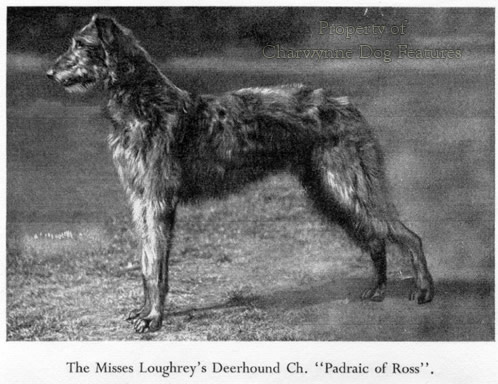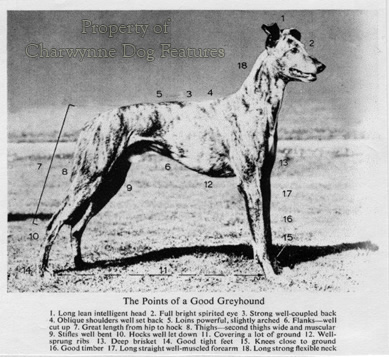731 PERPETUATING REAL SIGHTHOUNDS
PERPETUATING REAL SIGHTHOUNDS
by David Hancock
 Increasingly in the modern world, appearance is all; image matters more than substance and physical looks outweigh character and performance. This has sadly long been the case in the canine show ring. We all like a handsome dog but a dog that can nothing else but pose has a limited appeal to sportsmen. The highly successful racing Greyhound Mick the Miller and the impressively effective coursing Greyhound Master McGrath were always described as rather plain and unremarkable, until they started running, that is! Master McGrath was rather thick-set, with a shortish neck and for some, was too compact. Mick the Miller had no obvious outstanding features but also no significant defects. They have been referred to as the ugly ducklings of the leash and turf but only out of envy. Both had wonderful symmetry of build and superb balance; these are essential attributes in a running dog but are usually only revealed in performance.
Increasingly in the modern world, appearance is all; image matters more than substance and physical looks outweigh character and performance. This has sadly long been the case in the canine show ring. We all like a handsome dog but a dog that can nothing else but pose has a limited appeal to sportsmen. The highly successful racing Greyhound Mick the Miller and the impressively effective coursing Greyhound Master McGrath were always described as rather plain and unremarkable, until they started running, that is! Master McGrath was rather thick-set, with a shortish neck and for some, was too compact. Mick the Miller had no obvious outstanding features but also no significant defects. They have been referred to as the ugly ducklings of the leash and turf but only out of envy. Both had wonderful symmetry of build and superb balance; these are essential attributes in a running dog but are usually only revealed in performance.
Neither of these outstanding hounds displayed any sign of physical exaggeration. At Crufts in 2010 one sighthound judge commented: “I am concerned that over-angulated hindquarters seem to be becoming more prevalent, too long from the point of stifle to the hock. Not only does this spoil the balanced and symmetrical outline but is a serious fault as far as the functional capability of the Whippet is concerned.” This is a point very well made. The seeking of unnatural movement in the ring is also a curse. In her book on the Saluki, Ann Chamberlain writes, on ‘gaiting’: “The Saluki is a hunting breed, used for thousands of years in every terrain imaginable. To attempt to define the ‘show gait’ or the ‘proportion’ of the dog (i.e. in the breed standard, DH) after all these years seems not only unnecessary but also superfluous.” 
In her book on the Afghan Hound, Margaret Niblock writes: “The Standard succinctly describes the gait of the Afghan as ‘smooth and springy with a style of high order’ with a proud head carriage, far-away gaze and raised tail. This cannot be achieved if the animal is restrained by a tight grip on a short lead, or ‘strap-hanging’ as can be seen in terrier handling. It is miserably uncomfortable for the dog, which, choking and coughing, leans even more heavily against the collar in a frantic effort to put his feet on the ground for balance. The result is an unnatural, stilted, flailing or ‘knees up’ action in front and unbalanced over-thrusting from the hindlegs, often accompanied by knocking hock joints and leaning away from the handler. This misuse of hind muscles particularly in gangling youngsters, may cause permanent damage and unsoundness.” She was writing this over thirty years ago; if anything, abnormal ‘gaiting’ and stringing exhibits high up on choke chains is even more prevalent now than then.
The design specification, as always with a hunting dog, a sighthound especially, is to find the ideal match between quarry, country and conditions on one hand and speed, determination and hunting instinct on the other. The best judge of a sighthound is a man who has hunted one himself, a man who visualises the dog before him in the ring in the chase. But he has to possess some basic knowledge of the fundaments of hunting dog anatomy or he has no right to be in the ring as a judge. I see judges at shows who never look at the feet, never test the hardness of the loin, don't examine the bite, and reward entrants with slab-sides, upright shoulders and rib-cages which lack lung-room. That can only reward bad breeding, leading to a production-line of mediocre dogs; winning dogs get bred from! Lurcher shows may be mainly a bit of fun, but KC-approved shows for the sighthound breeds identify future breeding stock..jpg)
I don’t understand the justification for so many sighthounds, including lurchers, being so huge! It is worth remembering that the main reason why show Deerhounds tend to be enormous is not need but origin. Deer hunters found that dogs over 28" at the withers lacked performance and quickly passed them on to the early show breeders. No Waterloo Cup winner has ever been thirty inches high. I regularly see lurchers at shows which stand 30" and which must weigh 90-100 lbs. I would have thought that even on Salisbury Plain or around Newmarket, 60-70 lbs was easily big enough. The superlative coursing Greyhound Master McGrath, three times winner of the Waterloo Cup, believed by many to have no equal for pace, cleverness and killing power, weighed 52-54 lbs. Wild Mint weighed 45 lbs and Coomassie only 42; both were superbly effective coursing dogs. But whatever their size it is possible to judge these admirable dogs more effectively. If we are going to judge them, let's do it properly. A hound which hunts using its speed must have the anatomy to do so. Immense keenness for work will always come first but the physique to exploit that mental asset comes close second. A sighthound must have a long strong muzzle with powerful jaws and a level bite, with strength right to the nose-end of the muzzle. How else can it catch and retrieve its quarry? The nose should be good-sized with well-opened nostrils, for, despite some old-fashioned theories, sighthounds hunt using scent as well as sight.
For any sighthound to succeed, its eyes should be fairly prominent and be set slightly oblique, to the side of the head. One eye should look away to the right and one to the left so that, like any good rangefinder, both eyes can be used for long distance marking. It is likely however that at close range only one eye is used at a time. The neck should be long but symmetrically so, muscular and firm. Length of neck does not improve 'pick up'; flexibility in the 'swoop' comes from the placement of the shoulder blades.
A sighthound must have well laid back sloping shoulders; I always apply the 'two fingers width' test to the space between the shoulder blades of a dog with its head lowered. Many show greyhounds have to spread their feet to drink from a bowl of water on the ground because of excessive narrowness in the set of their shoulder blades. The sighthound’s back should hint at suppleness and power, be slightly arched in the lumbar region, yet have a mainly level topline. Any arching should be seated in the loin.
The chest should be deep from the withers to point of elbow but be fairly flat, with the underpart of the brisket fairly broad across. The ribs should be well separated, with good lung room and space between the last rib and the hindquarters to allow a full stride. At full stretch, the impress of a hare's hindfeet is implanted in front of that of the forefeet; the canine speedster should have the same capability. There must also be freedom of suspension in the ribcage or thorax in the way it is 'cradled' by the scapulae -- the dog needs to utilise this when hurdling a farmgate or turning at high speed.
The hindquarters must be powerfully constructed if they are to propel the dog forward in the chase, but symmetry and balance fore and aft are the key to turning ability. Every sighthound depends upfront on good long arms and forearms, and, in the hindlegs wide and muscular thighs and second thighs, length of stifle and good angulation. The feet must be really compact with well-knuckled toes and short claws, naturally worn from working or sound exercise. Some Greyhound experts have been known to assess a dog by looking at the tail first, noting any sign of coarseness, desiring the tail of a rat in appearance, long and whiplike with little hair. This to me is whimsical.
Smooth-coated sighthounds are sometimes handicapped by too little hair, lacking protection from wire and chill winds. Whilst not advocating a change of coat in any sighthound breed, I can see operational merit in a stiff-haired, wire-haired or linty coat. Ibizan Hounds can carry such a coat, but it’s one not favoured in the show ring. The jacket of any sporting dog should shed the wet not hold the wet. Waterproofing comes from hair density and texture not profusion of coat; if you look at the originally-imported Afghan hounds and then compare their coats to today's specimens, you can see how function has forfeited to fashion. Salukis develop a different coat in our climes. We need them to feature what is best for them, here, not us.
But the best physique is squandered without keenness in the chase and immense determination, an alert eager expression in the eye indicates this and is essential. Every sighthound judge has to ask himself: will this dog hunt? Can this dog hunt with this anatomy? Better function-judging, based on a more measured assessment, should lead to the production of better dogs. With coursing here confined to the past, we owe a great deal to the rich sporting heritage of our sighthounds and must breed canine sprinters to be just that. Country sportsmen have too much sense to allow the show ring sighthound breeds to degenerate into the pretty-polly state prevalent in far too many pedigree dog breed show rings. Lurcher shows are more a day out than any identification of future breeding stock: a bit of fun; the only real test for such a dog is in the chase. But that 'bit of fun' can raise standards too if the judges' criteria are sound. Who wants to win with an unsound incapable dog?
In his book on the Greyhound, published half a century ago, the great sighthound expert H Edwards Clarke wrote: “It soon became apparent to the early breeders of the Greyhound that their fastest dogs, generally speaking, were cast in a certain common mould. In the fullness if time they came to associate such physical features as tall straight forelegs, strong loins, powerful quarters, with the fullest endowment of speed and stamina. In their minds’ eyes they created a picture of the ideal Greyhound, of the conformation that in their experience had proved to be the most reliable and consistent vehicle of the breed’s great intrinsic qualities. This commonly accepted standard of physical perfection was drawn up long before dog shows had ever been thought of.” All sighthounds function as such from the design of their anatomy; if we seek to change that design to suit a contemporary whim, we threaten their claim to be real sighthounds.